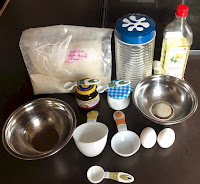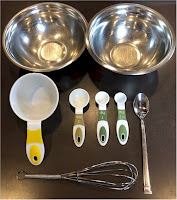Basic Sandwich Bread
Ingredients
Bowl 1
1 1/3 Cups warm water3 tbsp sugar
3 tsp bread yeast**
Bowl 2
2 eggs5 tbsp oil (I use safflower oil)
Bread maker/Bowl 3
4 Cups Bread Flour*1 1/2 tsp salt
Directions
Mixing
In a small bowl dissolve the sugar in the water. When it is clear, sprinkle the yeast all over the top of the water. Some will sink, some should stay in a layer on the top of the water. Allow the yeast to activate -- about 8 minutes or so depending on how lively the yeast is, how warm the water is and the room temperature.
While yeast is developing, crack the two eggs into a small bowl, add the 5 tablespoons of oil and beat until mixed.
Add the flour to a bread-maker if you have one, or a large bowl otherwise. Sprinkle the salt over the flour and mix a little until salt is distributed.
Once yeast mix is ready, pour the eggs over the flour in the breadmaker/bowl and pour the yeast mixture over that. Mix the dough until completely mixed and ready for kneading.
Kneading
Knead the bread (or allow the bread maker to do it if you have one) until it is smooth and stretchy. By hand this might take ten or twenty minutes depending on your skill. For this type of bread the dough should be thoroughly kneaded and smooth. If not smooth, the sliced bread may have holes that make it awkward to use.
First Rise
Allow the kneaded dough to sit in the bread maker or clean bowl in a warm area for about 90 minutes until the dough doubles in size.
Second Rise
After the dough has risen, press it down in the middle and divide it into two equal parts for two loaves of bread.***
The dough will be sticky. On a well-floured surface: dust your hands with flour and work the dough slightly to remove any large bubbles. Form into rectangles similar in size to your loaf pans. Place the rectangle into the loaf pan and press dough into the pan by pushing until the dough fills the pan is the same height and flat on top.
Cover the pans loosely with something that will allow air to circulate without drying out the dough and that will not stick to the dough after it rises. I use parchment paper.
Place the pans somewhere warm and not too dry. I turn the oven on for a minute to allow it to get warm and place the pans in the oven on the middle rack.
Allow the bread to finish rising and 'proofing'. In the warm oven above it takes about thirty to forty minutes for me.
Baking
At about the thirty-five minute point set the oven to pre-heat to 425 degrees F.
To test if the dough is ready, press it in gently about 5 mm and if it springs back about half way it is done. If it does not spring back at all it is over-proofed and if it springs back all the way it is under-proofed.
Once the oven and the loaves are ready, bake for 18-20 minutes until the crust is golden brown.
Slicing/Storing
Allow the bread to cool for at least 30 minutes before attempting to cut it. I usually wait about an hour. For the first few hours that the bread is fresh it is so delicate that it is hard to spread soft butter on it.
Pictures
Assemble the things you need
Implements You Will Need
Add 1 1/3 cup very warm water and 3 tbsp sugar
Stir to dissolve
Sprinkle 3 tsp yeast
Set 8 minute timer for yeast development
Mix 2 eggs 5 tbsp oil
Put 4 Cups flour, sprinkle 1 1/2 tsp salt
Add eggs and yeast mix to flour and mix
Knead and allow first rise. For our Black and Decker bread maker, set timer for 1 hour 45 minutes.
After first rise, shape loaves and allow second rise
When bread is nearly proofed (about 30 min) preheat oven to 425 degrees F.
When bread is proofed and ready to bake, bake at 425 degrees F. on middle rack for 18-20 minutes until golden brown.
Cool loaves on rack for about 30 minutes to an hour before slicing.
Notes
** Measure is based on using Fleischmann's Traditional Active Dry Yeast as in the image below.
*** If you wish, you can stop atter the first rise and put dough in a plastic bag in the fridge for baking the next day.













Comments
Post a Comment